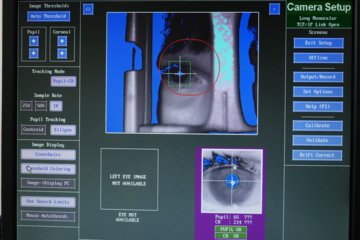A closer look at cognition
Pupil responses as potential biomarker for neurocognitive functioning
When our brains are solving a challenging task, our pupils dilate. In a new study, researchers found that the pupil size of most participants increased with increasing task difficulty (responders), while the pupil size of others remained unchanged (non-responders). Interestingly, non-responders generally performed worse on the tasks, and also had less brain activity in certain subcortical and neocortical regions. This suggests that pupil responses can be used to measure neurocognitive functioning, which plays a role in several psychiatric disorders.
It has long been established that the size of your pupil changes depending on what you are currently doing. If you are given a complicated task to solve, your pupil will typically increase in size. This change is not directly visible to the naked eye, but needs to be measured with high-tech instruments. In this study, researchers wanted to find out whether pupil responses among participants with and without psychiatric symptoms would show any differing patterns, and whether this knowledge could help to better diagnose and treat patients in the future.
Scientists from the Max-Planck-Institute of Psychiatry in Munich measured the pupil size of over 200 participants, some with and some without psychiatric symptoms, who were trying to complete a challenging task. While most showed the expected increase in pupil size the more complicated the task became (responders), it remained unchanged for other participants (non-responders). "We observed that non-responders also performed worse on other cognitive tasks, such as paying attention to letters or numbers being presented in a consecutive manner.
They also performed worse on tasks assessing cognitive flexibility," says first author Julia Fietz. In addition, non-responders also had less activity in several brain regions, including the thalamus. The thalamus is a brain region that plays a central role in attention, cognition and memory. "It seemed as if non-responders could not upregulate their arousal to perform the task optimally," Fietz notes. However, being a responder or non-responder was not associated with having psychiatric symptoms – this means that there were not significantly more non-responders among psychiatric patients than there were among the healthy controls. The pupil response purely tracked cognitive function across groups.
Pupillometry as potential biomarker
This finding could help with the early detection of small changes in cognitive functioning: "It doesn't replace neuropsychological testing, but it makes the same tests more sensitive to detect those small early differences”, says research group leader Victor Spoormaker. “Pupillometry has the advantage that it's non-invasive, automated and digitally measurable through mobile platforms. It could mean a novel digital biomarker for cognitive functioning, which is relevant for depression but also neurodegenerative diseases."
Contrary to other diseases like cancer, psychiatric disorders are not diagnosed using objective methods such as laboratory tests. They are instead diagnosed using subjective methods like questionnaires and patient conversations. Supplementing these methods with biomarkers could therefore help make diagnoses more precise, which could then help to treat patients in a more individualized manner.











